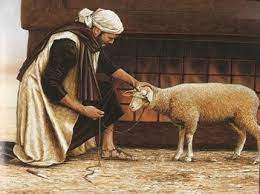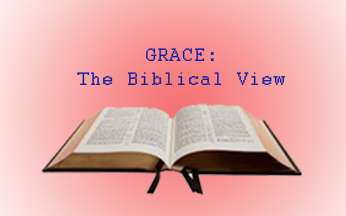

Sin Offering: Meaning and its New Testament Fulfillment
Pr. Sam K. Jacob
From the earliest time until the destruction of the second temple, Hebrew religion was marked by a series of rites and ceremonies , both public and private in which animals were consumed. Throughout the Old Testament, there are numerous references to sacrifices and offerings in the life of nation as well as in individual lives. Though in certain occasions the Old Testament Prophets were critic about it(cf.Isa-1:11-14),the purpose of such preaching was to shake the people out of their lethargy. A sacrifice involves the slaughter or burning of an animal, while an offering does not. Hebrew sacrifices and offerings are classified according to their respective motivations. The core of the sacrificial system of ancient Israel consists of the five major kinds of sacrifices and offerings.Lev.1-7 deal with the basic regulations and 8-16 describes foundational application which focused on the system as it functioned within the tabernacle. The purpose of the sacrifices and offerings within the sanctuary system was to provide a means of approaching the Lord in his place of manifest presence in Israel. It is regarded that the most important sacrifice was the sin offering, which always preceded the other sacrifices and played such a key role on the Day of Atonement.
Sin Offering: Etiomology
Of the various Old Testament words for sin, ‘hattat’ is the most frequent occurring, along with its derivatives. The literal meaning of this word is “missing the mark”.The Greek equivalent is ‘hamartia’.The term also denotes being at fault, out of harmony with the prescribed order of things, failure to perform a duty or to be lacking. Depending on its usage in context, hattat can mean either ‘sin’ or ‘sin offering’. According to Lev.4:3 a priest must bring to the Lord a young bull without defect as a sin offering(hattat) for the sin he has committed. It is notable that another derivation of hattat suggests the meaning ‘purification offering’. Before the altar of burnt offering and the Tabernacle could serve as a meeting place between God and His people, as sin offering was required. Because purification was the main element in this sacrifice, some have preferred to call it the purification offering.
Offering refers to the presentation of a gift. It is a broader term than sacrifice, which refers to making something sacred. In Hebrew, the term for offering ‘qorban’ is a more general term than sacrifice(zebah).
Sin Offerings in the Ancient Near East
There are apparently no examples in which the root word or any of its derivatives is used for ritual purification. Yet, the concepts associated with the sin offering were well known in other ancient Near Eastern ritual literature. It has been observed that the Hittite and other ritual text that purity of the sacred precincts of sanctuaries was a most serious concern. Also , there were various kinds of scapegoat rituals that, to one degree or another ,correspond to the Leviticus 16 scapegoat purposes and procedures for purification of the sanctuary.
The Basic Regulations for Sin Offerings
The purpose of the sin offering was related primarily to that altar of burnt offering (Ex.29:10-14,36-37). In that costly sacrifice, a bull without defect, the most essential part was the blood. The fatty parts were offered on the altar, and the rest was burned outside the camp. The blood was applied to the horns of the altar, making’atonement for the altar ‘purging it through an act of purification so that burnt offerings could be made on it in worship of God. The original ritual of the sin offering was repeated for seven days (Lev.8:14-17;9:8-11,15).
At the dedication of the Tabernacle, when the altar of burnt offering was atoned for, purified, and consecrated through the blood of the sin offering,the glory of God appeared. In a fiery divine manifestation, the offering on the altar was consumed(Lev.9:23-24).The confirmation of God’s promise that He would meet with the Israelites at that altar(Ex.29:42-43)was witnessed by them.
Once the altar had been purified for worship, it was not required that a sin offering be offered every day, since the altar was purified daily by the blood of each burnt offering.
The sin offering was, ,required annually on the Day of Atonement(Lev.16),when the blood from the sin offering for Aaron and his household and from the sin offering for the people was applied to the Ark of the Covenant ”to make atonement for the most Holy Place “(16:11-17).It was also applied on that day to the horns of the altar of burnt offering to make atonement for it(16:18-19).The altar of incense in all likelihood was also purified by the blood of those sin offerings(Ex.39:7-10).
The blood of a sin offering was always applied to purify or make holy material objects involved in a meeting between God and man. The altar of burnt sacrifice was cleansed ”from the uncleanness of the Israelites”and consecrated through the application of the blood(Lev.16:19).
For any other violation of the Lord’s commands(Lev 4:2; 5:1-4) the stipulations for the parties concerned were: for the priest, a bull(Lev 4:3-12);for the whole congregation, a bull(Lev 4:13-21);for the leader of the congregation, a male goat(Lev 4:22-26);for a common Israelite, a female goat(Lev 4:28; 5:6) or a female lamb(Lev 4:32,5:6)or, as a concession to the poor, either two doves/pigeons(Lev 5:7)or a simple grain offering with no oil or incense(Lev 5:11-13).Clearly the relative value of the required offering corresponded to the relative status of the person who brought it. The worshiper would bring his animal to the priest, place his hand on its head while stating the reason for his offering, and then kill the animal. The priest saved the blood. Although most of the blood was poured out at the base of the altar, the priest reserved some for applying in a variety of ways, depending on the identity of the worshipper.
If an anointed priest sinned, he took the blood of a bull into the Tabernacle and sprinkled it with his finger seven times before the Lord in front of the curtain that hid the Holy of Holies, the innermost part of the Tabernacle. Then he applied some of the blood to the horns of the altar of incense(cf.Ex.30:1-10).Returning to the altar of burnt offering, the priest would pour out the rest of the blood and offer the fatty parts of the animal on the altar. The rest of the animal was taken outside the camp, to the place where ashes were thrown, and burnt in a wood fire(4:3-12).The book of Hebrews alludes to this procedure in speaking out Jesus’ suffering outside the gate(Heb.13:11-13).
When the offering was for the whole Israelite community, the elders brought the offering and the same ritual was followed. The priest made “atonement for them” with the assurance that” they will be forgiven”(4:13-21).
When a leader or a member of the community brought a sin offering, the priest applied the blood to the horns of the altar of burnt offering. As the worshipper and the priest completed the offering,t he worshipper was assured that atonement had been made for his sin “and that he will be forgiven”(Lev.4:22-35).
Whereas Leviticus 4 describes offerings brought for unintentional sins,Leviticus 5 prescribes the sin offering for sins of omission: failure to give witness in court(v.1),ceremonial uncleanness(vv.2-3),and neglect of self imposed obligations(v.4).In each of those cases, when an individual became aware of his guilt,failure,or neglect,he was required to do something about the condition or situation that had been neglected.
If an Israelite could not afford a lamb or two doves or two young pigeons, he was allowed to substitute a tenth of an ephah(roughly two quarts or two liters)of fine flour, which represented sustenance for one full day(cf.Ex.16:16).Although flour was a bloodless offering, the burning of a memorial portion mixed with the other burnt offerings gave it the status of a blood sacrifice.
When the priests were allotted a portion from the sin offering, they were to eat the meat in the courtyard of the Tabernacle (6:24-30).The sin offering was compulsory for the Israelites who were guilty of unintentional sins and sins of contamination not committed deliberately. Repeatedly the statement occurs that when they became “aware of the sin”(4:14,23,28) an offering was required. When individuals were “unaware” (5:2-4) of their sin in matters of injustice, defilement, uncleanness or thoughtlessness, a confession and a sin offering were required when they became aware of their guilt.
Sin Offering and Guilt Offering
Closely linked with the sin offering was the guilt offering, which also dealt with specific sin. Although there was some overlap between the two offerings, the guilt offering was required when restitution was possible after another person had been wronged. Whenever the different sacrifices were offered together, the sin or guilt offering always came first, followed by the burnt and fellowship offering(Lev.9:22;Num.6:16-17).This order was important theologically, for confession of sin had to precede the consecration of the worshipper to God(represented by the burnt offering).Third came the fellowship offering, which reflected the reestablishment of communion and fellowship with God. Through these offerings sin could be atoned for, and a cleansed and forgiven people could enjoy the presence of their God.
The uses of sin offering
The sin offering was used in various occasions such as
1. At the consecration of the priest (Ex.29:13, Lev.8:2)
2. The inauguration of altar worship (Lev 9:2-7, 8-11,15-17)
3. The tribe-by-tribe dedication of the altar (Num 7:16 etc)
4. The consecration of the Levites (Num 8:8,12)
5. On regular monthly occasions (Num 28:15)
6. At annual festivals (see Lev 23:19; Num 28:22; 29:5,16-38) and especially on the annual Day of Atonement (Ex.30:10; Lev.16; Num 29:11).
Other specific situations that could occur anytime during year would also require a sin offering, for example, the cleansing of a woman after childbirth (Lev. 12:6-8), the cleansing of a leper (Lev. 14:19,22,31) and the cleansing from unclean discharges (Lev.15:15,30)
N.T. Fulfilment
For the New Testament writers the levitical sacrifices was a matter of importance. The writer to the Hebrews tells us that the sacrifice that Jesus brings is far greater and effective (9:11-14). On the day of Atonement the blood from the sin offering was sprinkled on various parts of the tabernacle to cleanse it and to consecrate it (16:19). Cleansing, purification, sanctification and consecration are repeatedly connect with bringing a sin offering (Lev.12:8,14:19,15:3).The precious blood of Jesus cleanses, purify and sanctify a person and becomes the temple of God (cf.1 Cor.3:16). As Apostle John says, the blood of Jesus purifies us from all sin and unrighteousness (1 Jn.1:7,9).
A unique feature of the day of Atonement was the sending of scapegoat to a solitary place after Aaron placed his hands on it and confessed over it all the sins of the people. Likewise, Jesus took away the sins of the people by offering himself for the whole humanity(Jn.1:29) .In Hebrews 13:11-12 the death of Christ ‘outside the city gate’ is compared to the burning of the sin offering ‘outside the camp’. So, we have to go to Him outside the camp, bearing the disgrace he bore (cf.13:11-14).
The offerings were basic to the relationship between God and Israel. The sin offering provided purification for the Israelite so that he could approach God. The blood of Jesus helps us to maintain an exclusive relationship with God.


